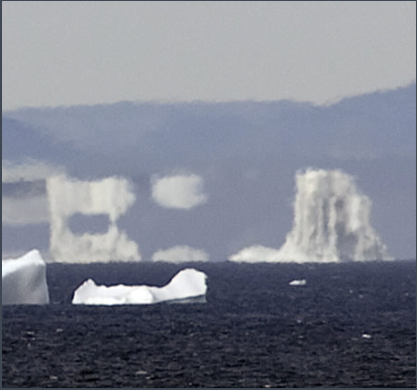Disco Mirage
Disco Mirage: A Symphony of Reflection and Distortion
Disco Bay, located in Greenland, is a place where atmospheric optics come alive. Amidst the majestic icebergs, a phenomenon known as a disco mirage can be witnessed, creating a symphony of reflection and distortion. While the closer icebergs may not display visible mirages, the more distant scene becomes a captivating display of optical illusions.
The Elusive Mirages
Above most of the distant icebergs, an inverted image hovers in the air. Just above that, a third image of the iceberg appears erect again. These inverted images are elongated with vertically ribbed features, resembling ethereal castles in the sky. Irregular dark bands float across the areas where the inverted and erect images converge, further enhancing the mirage. This captivating display is an example of a superior mirage, adorned with elements of Fata Morgana, which creates the illusion of high-rise buildings.
The Role of Temperature Inversion
The phenomenon behind this mesmerizing mirage is a temperature inversion. As the icy cold sea cools the air in contact with it, a layer of unusually cold air forms beneath the warmer air. This temperature inversion is visible as a ragged line against the distant mountains.
Refraction and Curvature
When light rays pass through the dense colder air and the upper warm air, they undergo refraction. As a result, the path of these rays becomes curved and concave towards the horizon. This curvature is strongest where the vertical temperature gradient is greatest.
- The curvature of rays tends to curve downward, always bending towards the cooler and denser air.
- Rays from the top of the iceberg are slightly curved, making them appear to originate from a point above their actual location.
- Rays from the base of the iceberg encounter a higher region with an even greater temperature gradient, causing stronger refraction. This results in the formation of an inverted image above the real iceberg.
The Third Image
In addition to the inverted images, rays from the top of the iceberg have another route available. They can pass through the upper warmer air before curving down towards the observer or camera. This alternative path creates a third image of the iceberg, this time in its correct orientation.
A Towering Mirage
Within the disco mirage, Fata Morgana architectural embellishments add a touch of grandeur. These mirage-induced structures appear as towering formations, further enhancing the surreal atmosphere of Disco Bay. Meanwhile, inverted counterparts float above the icebergs, adding to the overall spectacle.
The disco mirage is a captivating example of how atmospheric conditions can create mesmerizing optical illusions. By understanding the role of temperature inversions and refraction, we can appreciate the intricate beauty of mirages in nature. Disco Bay stands as a testament to the wondrous world of atmospheric optics, where reality and illusion intertwine to create a symphony of reflection and distortion.
(Note: This article has been automatically converted from the old site and may not appear as intended.)

Miraged Icebergs at Disco Bay, Greenland Two panoramas by Lars Brub�k. Taken from the motor ship 'Fram' at a height of 15m above sea level. The camera points east towards either Arveprinsens Island or mainland Greenland. Scroll right for the majesty of the berg strewn sea. �Lars Brub�k, sown with permission.

There is much going on over Disco bay. The closer icebergs are not visibly miraged but the more distant scene is a symphony of reflection and distortion.
Above most of the distant bergs floats an inverted image. Above that is yet a third
image. In that one the berg is erect again. The inverted images are elongated with vertically ribbed �architectural� features ~ castles in the air. Irregular dark bands float roughly across where the inverted and erect images are closest � The dark sea surface is itself being miraged. Overall, this is a superior mirage embellished in parts with Fata Morgana �high rise buildings�.

A temperature inversion is responsible. The icy cold sea cools the air it is in contact with forming an unusually cold layer beneath warmer air. The inversion top is visible as a ragged line against the distant mountains.
Light rays passing between the dense colder air and the upper warm air are refracted. The ray paths become curved and concave to the horizon level. I.e. they tend to curve downward. The curvature is always such that the rays tend to curve towards the cooler - denser - air. The ray curvature is strongest where the vertical temperature gradient is greatest.
At right, the ray 'b' from the real berg top is slightly curved making it appear to originate from a point above. Ray 'c' from the berg's base encounters a higher region of even greater temperature gradient and is more strongly refracted. A rule of thumb is that where ray crossing occurs the resulting image is inverted. An upside down berg floats over the lower one!
Rays from the berg top have a third route 'd' available through upper warmer air before curving down towards the eye or camera. These form a third image - this time the right way up.

At right, Fata Morgana architectural embellishments create a towering structure.
At left, inverted counterparts float over the bergs.
Note: this article has been automatically converted from the old site and may not appear as intended. You can find the original article here.
Reference Atmospheric Optics
If you use any of the definitions, information, or data presented on Atmospheric Optics, please copy the link or reference below to properly credit us as the reference source. Thank you!
-
<a href="https://atoptics.co.uk/blog/disco-mirage/">Disco Mirage</a>
-
"Disco Mirage". Atmospheric Optics. Accessed on November 26, 2024. https://atoptics.co.uk/blog/disco-mirage/.
-
"Disco Mirage". Atmospheric Optics, https://atoptics.co.uk/blog/disco-mirage/. Accessed 26 November, 2024
-
Disco Mirage. Atmospheric Optics. Retrieved from https://atoptics.co.uk/blog/disco-mirage/.